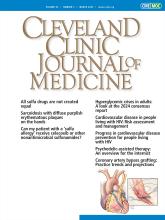To the Editor: I am writing to commend the review by Dr. Mehta and colleagues1 on classic and euglycemic diabetic ketoacidosis (DKA), which highlights the evolving clinical challenges that clinicians face in diagnosis and management. I would like to offer a few reflections and questions that may further stimulate discussion on this important topic.
First, I value the authors’ emphasis on identifying euglycemic DKA, which frequently manifests in an unconventional way—ie, with blood glucose levels that are normal or almost normal. This variation presents a diagnostic conundrum, particularly in patients who do not exhibit conventional hyperglycemia, as the authors note.1 Although ketosis and an elevated anion gap are well-established diagnostic criteria for euglycemic DKA, further research is necessary to find early biomarkers or other clinical signs that could help differentiate euglycemic DKA from other conditions that might present similarly. For instance, future research could examine the function of high serum beta-hydroxybutyrate as an early signal.2
I also want to bring up the issue of euglycemic DKA care. According to the paper, this variation frequently affects people on sodium-glucose cotransporter 2 inhibitors, which might obscure hyperglycemia and thus complicate the clinical picture. The authors stress how crucial it is to diagnose euglycemic DKA in these patients in order to prevent delays in receiving the right care. However, considering the difficulties these patients have with fluid shifts and renal function, I would like to know if the authors have any thoughts on whether early intravenous insulin therapy or modifications to fluid management techniques would improve outcomes in these situations.3
Last, the article’s mention of the significance of educating and raising clinician’s understanding about euglycemic DKA is quite pertinent. I think there might be a chance to create more focused clinical guidelines or decision-support systems to help physicians recognize this variant sooner, especially as sodium-glucose cotransporter 2 inhibitors are being used more often in the treatment of diabetes. This might lessen the possibility of an incorrect diagnosis or postponed therapy.
Given the circumstances, I applaud the authors for their efforts to better comprehend this intricate clinical phenomenon and to improve our understanding of DKA in all its manifestations. As we continue to advance our methods for diagnosing and treating persons with diabetes, I am excited for more studies and conversations in this field.
- Copyright © 2025 The Cleveland Clinic Foundation. All Rights Reserved.






